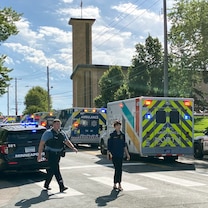Us Prostate Cancer Rates Rose Annually Over The Past Decade, New Report Finds

The steepest increases were seen for advanced-stage disease.
Prostate cancer rates have risen in recent years, with a sharp increase in cases diagnosed in advanced stages, the American Cancer Society said Tuesday.
Diagnoses of prostate cancer rose 3% annually starting in 2014, after declining 6.4% in the decade before, according to the ACS' annual prostate cancer statistics report.
The steepest increases were seen for advanced-stage disease — up to 6.2% annually with the increases varying by age groups, the report said.
Simultaneously, the report shows declines in mortality slowed from 3%-4% per year during the 1990s and 2000s to 0.6% per year over the past decade.
Following the U.S. Preventive Services Task Force's recommendations against a routine prostate-specific antigen (PSA) screening in the early 2010s, rates of advanced-stage prostate cancer began rising again, the report suggests.
"We actually see PSA testing this decade versus the previous decade going down, so the incidence [of prostate cancer] is going up despite less testing occurring, which is an interesting anomaly," Dr. Arif Kamal, oncologist and chief patient officer at the American Cancer Society, told ABC News. "It starts to speak to other factors that might be environmental or nutritional or other things that may be at play that we don't fully understand."
PSA testing is a key tool in early detection and contributes to early diagnosis and improved survival but may have led to overdiagnosis when it was used routinely, the paper suggests. But attempting to limit overdiagnoses may be contributing to the rising incidence of the advanced-stage prostate cancers, Kamal said.
All men age 45 and above should have a discussion with their doctors about the right time to be tested for prostate cancer, Kamal advised. A doctor might recommend no testing, but for many men, having some sort of testing regimen is the best path.
The ACS has suggested federal legislation to waive cost-sharing requirements such as deductibles and copayments for prostate cancer screening tests for men at high risk for the disease.
Prostate cancer death rates were two times higher for Black men compared to any other racial or ethnic group, according to the report. Likewise, the report found Native American men had a 12% higher rate of death from the disease compared to White men, despite a 13% lower incidence.
"Oftentimes we might think of a one-size-fits-all approach to how we manage risk and how we have these conversations, but certainly if we know that certain populations based on their backgrounds may have higher mortality, it might change our threshold for the testing we do, the urgency by which we do it, and the frequency by which we do it," Kamal said.
Prostate cancer is the most common cancer diagnosis among men in the U.S., accounting for 30% of male cancers in 2025, and is the second leading cancer death in men behind lung cancer, according to the ACS.
"What's interesting is that for many patients the conversation around a PSA and the discussion of the result then highlights other components of someone's health history that may also be important," Kamal noted. "Men generally don't like coming to the doctor and so this gave a focal point to have a conversation about prostate health but also things beyond that."
Raihan El-Naas, MD is a board-certified internal medicine physician and current endocrinology fellow at Weill Cornell Medical Center and Memorial Sloan Kettering Cancer Center and a member of the ABC News Medical Unit.
Popular Products
-
 Fatty Liver Cleanse & Detox
Fatty Liver Cleanse & Detox$113.99$78.78 -
 Stainless Steel Tongue Scrapers
Stainless Steel Tongue Scrapers$24.99$16.78 -
 Magnetic Waist Twisting Disc Body Tra...
Magnetic Waist Twisting Disc Body Tra...$53.99$36.78 -
 Rechargeable Electric Face & Beard Tr...
Rechargeable Electric Face & Beard Tr...$47.99$32.78 -
 Adjustable mini Exercise Bike
Adjustable mini Exercise Bike$300.98$240.78


